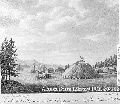|
Eager Russian fur traders wasted no time after learning of the superb furs awaiting them in the newfound region. By 1743, private traders known as promyshlenniki were were sailing east to hunt sea otters seasonally; slowly others began the colonization process. By the late 1790s the settlers had established permanent hunting and trading posts throughout the Aleutians, on the Alaska Peninsula, and in southeastern Alaska.
Although Catherine the Great had urged peaceful dealings between the fur traders and Alaska's Natives, in truth the Aleuts (Unangan) and later other coastal tribes would suffer greatly as skilled hunters of the villages were forced to hunt for the Russians, leaving other family members to fend for themselves. The promyshlenniki were sometimes brutal in their attempts to coerce the Natives, from threats to kidnappings to killings.
Conflicts between Russian and indigenous people also accelerated with growing competition between the trading corporations that had begun to merge into fewer and more powerful companies. One of these giant corporations was the Shelikhov-Golikov Company, which soon monopolized the fur trading industry in Alaska.
The resource-rich region did not go unnoticed by others in the European world. The presence of Spanish and British explorers threatened Russia's hold on its interests. From 1776 to 1779, Captain James Cook explored the coast and his findings encouraged the crown to enter the fur-trading business. Soon Great Britain had established three Alaska-based trading posts at Fort Yukon, on the Stikine River, and in Wrangell.
In 1784, Grigory Ivanovich Shelikov, along with the crew of his two ships, arrived on Kodiak Island. Shelikov, cofounder of a monopoly that later was chartered as the Russian-American Company, found resistance among the Natives, who attacked the foreigners. Shelikov retaliated by slaughtering hundreds and taking more as hostages. He then founded the first permanent Russian settlement in Alaska and built Russian schools on Kodiak Island. Shelikov sent for Russian clergymen to convert the Natives to the Russian Orthodox religion. In schools and churches, Aleuts were forced to abandon their Native language, customs and spiritual beliefs, and learn how to read and write Russian.
Shelikov returned to Russia in 1790 and hired Aleksandr Baranov as chief manager of the monopoly. In 1799, Catherine the Great's successor, Paul I, issued the charter that created the Russian-American Company. At the helm, Baranov oversaw all of the company's fur-trading posts in Kodiak as well as in the Aleutian and Kuril Islands. However, Baranov noted that the Tlingits in Southeast were trading with non-Russian Europeans. Concerned by the loss of revenue for the Russian-American Company, in 1795 he established Mikhailovsk, a fur-trading post just north of present-day Sitka.
Despite resistance from local people, the Russian-American Company overpowered the Tlingits in the Battle of Sitka in 1804 and took over all fur-trading activities in Alaska. Baranov managed the Russian-American Company from 1799 to 1818, including moving the capital of Russian America from Kodiak to Sitka (New Archangel) in 1808 to further exploit the sea otter population there. Baranov was influential in building more schools and easing the isolation among the frontier communities. He clashed often with Russian missionaries who had exposed the Russians' cruelty and exploitation of the Native people.
It was too good to last for the Russian-American Company. Soon profits began to fall as a result of overhunting and dependence on American ships for supplies. With growing money problems and anxiety over further British advancement, the Russian government approached the U.S. about buying Alaska.
The U.S. Senate approved the purchase treaty on April 9, 1867, by a vote of 37 to 2; however, gaining approval within the House of Representatives created delays. At last, the House approved the treaty by a vote of 113 to 48. The American flag was raised over Sitka on October 18, 1867, now a state holiday called Alaska Day. But Alaska was not really a territory yet -- its official status was Department of Alaska. In 1884, the First Organic Act provided some semblance of government, and Alaska was redesignated as the District of Alaska. Territorial status arrived in 1912 with the Second Organic Act. From purchase to statehood, more than 90 years would pass.
|
 |
 |
| Abacus used in the office of the Russian America Company in Sitka |
|
|
|
 |
| Aleksandr Andreevich Baranov (Baranoff) |
|
|
|
 |
| Catherine II, Empress of Russia |
|
|
|
 |
| Drawing of Sitka in 1805 |
|
|
|
 |
| Norfolk, Sitka Sound, Alaska |
|
|
|
|




